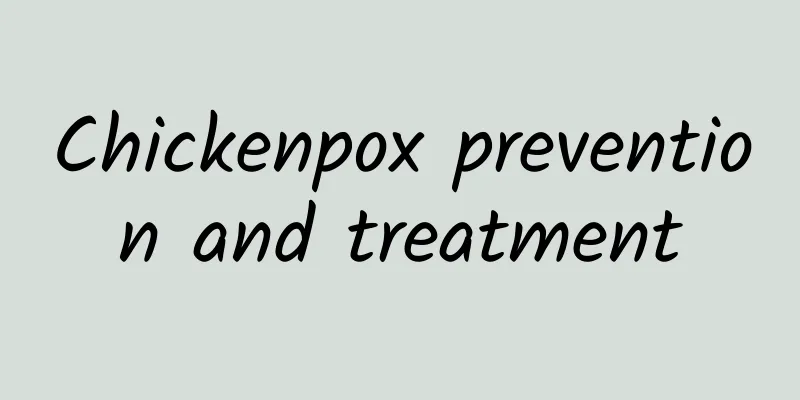Chickenpox prevention and treatment

|
Chickenpox prevention and treatment Chickenpox is a highly contagious childhood rash disease caused by the varicella-zoster virus (VZV). It is common in winter and spring. It is transmitted (infected) by droplets or contact, and long-lasting immunity can be obtained after infection. Common complications of chickenpox include skin infection, pneumonia, encephalitis, facial nerve paralysis, Reye syndrome, etc. Newborns, immunocompromised patients, and critically ill patients are at risk of death. 1. Pathogen and epidemiology The varicella virus has humans as its only natural host. The virus has weak resistance in vitro and is sensitive to heat, acid and various organic solvents and cannot survive in the scab. Varicella patients are the source of infection of varicella, and the transmission routes are droplets, direct contact with patients, or contact with items contaminated by patients' herpes serum. The general population is susceptible, mainly seen in children aged 2-6 years, and occasionally in adults. The incubation period is 10-21 days, usually about 14 days. About 90% of close contacts will develop the disease. The infectious period is from 1-2 days before the rash appears to the last skin lesion scabs and dry, about 7-8 days. It is recommended to isolate at least 10 days after the onset of the disease, and preferably isolate until 2 weeks after the onset of the disease. 2. Diagnosis points 1. Most patients have a clear history of contact, with an acute onset, and may have fever, loss of appetite, headache, abdominal pain, etc. Within 24 hours of onset, skin rashes or herpes the size of rice grains to peas appear in batches, followed by ulceration and scab formation. 2. Skin rashes are distributed centripetally (more on the trunk, followed by the head and face, and less on the limbs). The four generations of rashes coexist (i.e., macules, papules, herpes, and scabs coexist in one patient). Some mucous membranes are also often invaded, and skin rashes (or herpes) are seen in the mouth, throat, conjunctiva, vulva, anus, etc. 3. Laboratory examination: (1) The white blood cell count in a routine blood test is normal or slightly low, and the lymphocyte count is relatively increased. (2) Herpes scraping test: Take fresh herpes fluid for smear and stain with Wright stain to find megakaryocytes. (3) Varicella-zoster virus antibody test. (4). Virus isolation. 3. Key points of treatment 1. General treatment: change underwear frequently, cut the child's nails short, wear gloves to prevent scratch infection, maintain air circulation, eat light and easy-to-digest food, drink plenty of water, supplement vitamins (eat more vegetables and fruits), etc. 2. Drug treatment: Chickenpox is a self-limiting disease and can be treated symptomatically if there are no complications. (1) For skin itching without ulceration, calamine lotion or gentian violet solution can be applied topically. For ulceration, ethacridine solution or antibiotic ointment can be applied. For severe itching, a small amount of sedative can be given. (2) Antiviral treatment: Acyclovir is the first choice antiviral drug for the treatment of varicella. Some experts suggest that acyclovir should be used in children without complications, but routine use is not recommended. Some experts also suggest that it should be used as early as possible (within 48 hours of the appearance of skin rashes, oral acyclovir 20 mg/kg/time, 4 times a day, but the maximum single dose should be ≤800 mg/time. For patients with complications, immunosuppression, and severe cases, experts agree that intravenous administration should be used, 10-20 mg/kg/time, 3 times a day, for 7-10 days or until no new skin rashes appear for more than 48 hours. (3) Patients with bacterial infection can be treated with antibiotics. (4) Hormones are prohibited (current general consensus). 4. Prevention 1. Patients must be isolated and treated, and those with a clear diagnosis must fill out and submit an infectious disease report card in accordance with regulations. 2. Close contacts should be isolated, observed and quarantined for 3 weeks. 3. Carry out popular science education for the general public to enhance their awareness of disease prevention. 4. Vaccination with live attenuated varicella vaccine (vaccination is not recommended for immunodeficient/suppressed patients). 5. Close contacts can be given intramuscular injection of 2-4 ml of immunoglobulin or high-valent immune serum. |
<<: Tremella and cabbage can nourish yin and moisten dryness
>>: Food Safety | Do you like fried food? Heart disease also likes you!
Recommend
The best time to remove moisture after childbirth
Childbirth is something that every woman has to g...
What to do if bank deposits mature during the epidemic? How to calculate the interest on automatically extended deposits during the epidemic?
As we all know, due to the impact of the new coro...
Hypothyroidism during pregnancy, no medication, healthy child
If I don't take medicine for hypothyroidism d...
At what age does menstruation usually start?
Whether it is a boy or a girl, growth and develop...
What to do if you drink alcohol without knowing you are pregnant
Without knowing whether you are pregnant, if the ...
Eight taboos in the life of pregnant women
The physical health of pregnant women is an issue...
What is the reason for the itchy lower body?
Female friends must not ignore the problem of wet...
Sequelae of uterine interventional embolization
Many older women suffer from various gynecologica...
Postpartum wrist pain, this can remedy
There is a saying that you must be careful if you...
39 weeks lower abdomen pain
At the 39th week of pregnancy, some friends will ...
Causes of hair loss in pregnant women
Nowadays, there is an interesting social phenomen...
Will fallopian tube intubation cause bleeding?
Fallopian tube insufflation is a relatively commo...
What are the ways to remove crow's feet?
It is said that young girls love beauty. However,...
Which is more harmful to the body, induced labor or natural birth?
In daily life, induced labor is a way for women t...









